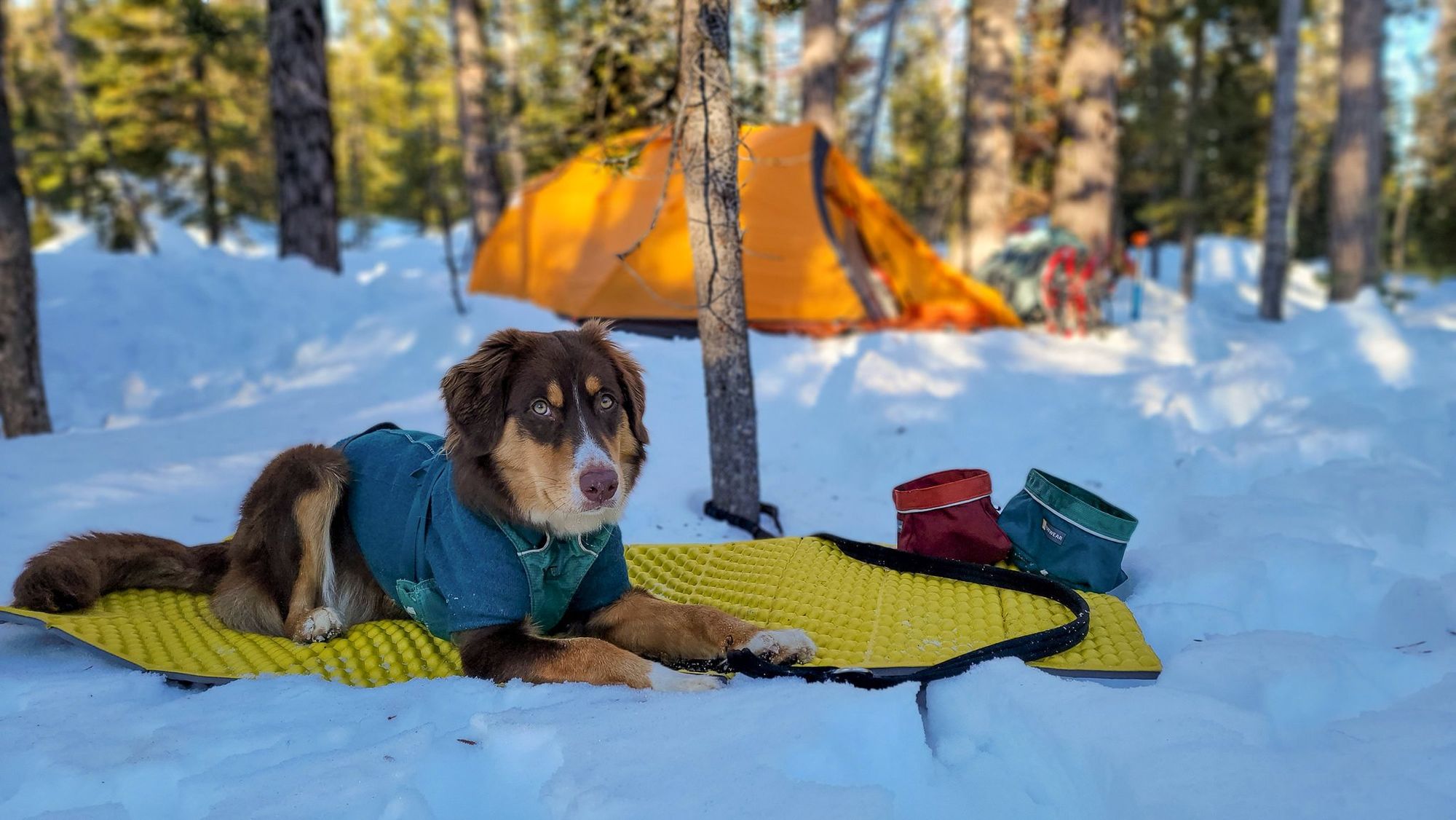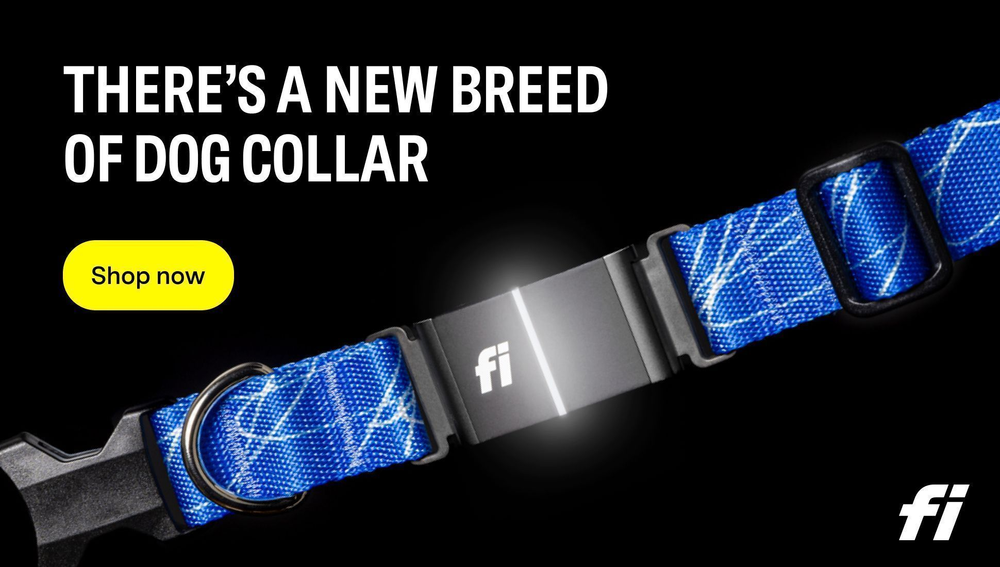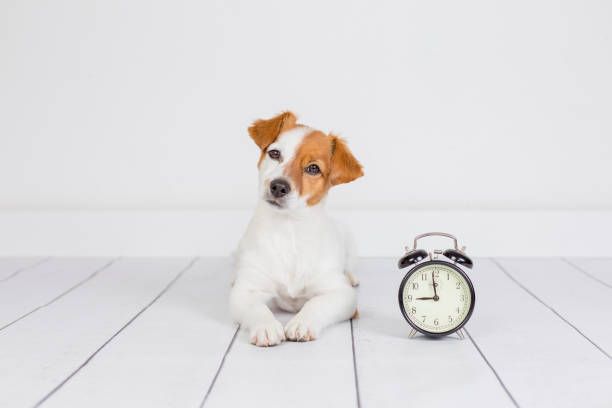Winter camping with your pup can be a thrilling and heartwarming experience! The chilly temps create a special backdrop, great for exploring snowy surfaces and savoring the tranquility of nature. To have a secure and pleasant journey, it's crucial to get ready and think about your dog's exact needs.

Planning for winter camping with a pup? Here are some must-knows:
- Train your pup well, especially in cold weather.
- Pack warm blankets, insulated jackets, and booties to protect their paws.
- Carry enough food and water for both of you.
- Look for pet-friendly campgrounds that allow dogs in winter.
Plus, remember these details:
- Check the weather before going.
- Bring a portable bed for comfort and insulation.
- Pack extra towels for drying off after outdoor activities.
- Watch for signs of discomfort or hypothermia.
Tip: Talk to your vet first to make sure your dog is fit for winter camping.

Essential Gear for Winter Camping with a Dog
Camping in winter with your dog requires certain essential gear to ensure their safety and comfort. Here are the key items you'll need:
- Insulated Dog Bed: Provide your furry friend with a cozy sleeping spot to keep them warm throughout the night.
- Winter Dog Coat: Keep your dog protected from the cold weather with a well-fitting and insulated dog coat.
- Dog Boots: Protect your dog's paws from ice, snow, and freezing temperatures with durable and non-slip dog boots.
- Extra Food and Water: Your dog will need additional calories to keep them energized in the cold. Make sure to pack extra food and clean water.
- Reflective Gear: Visibility is important, especially in snowy conditions. Equip your dog with reflective gear, such as a collar or leash, to ensure their safety.
Additionally, it's essential to consider some unique details for winter camping with a dog. Remember to bring pet-friendly de-icer for the campsite area and always keep your dog on a leash to prevent them from getting lost in unfamiliar surroundings.
Warm Clothing and Boots for the Dog
To keep your pup warm and safe while winter camping, the following gear is essential:
- Insulated jackets: Traps heat to keep your dog toasty during the chilly nights.
- Waterproof boots: Prevents ice balls and provides insulation and traction.
- Fleece-lined sweaters: Adds an extra layer of warmth while allowing flexibility.
When picking out warm clothing and boots, consider:
- Adjustable gear for your dog's size and breed.
- Reflective elements to increase visibility in low-light conditions.
- Activity levels and preferred outdoor activities.
For the gear to work effectively, make sure to:
- Get the right measurements.
- Choose durable, waterproof and breathable materials.
- Look for easy-to-clean or machine washable fabrics.
Be sure to get your pup all kitted out with the right gear - that way you can both have a safe and comfy adventure in the great outdoors!
Sleeping Gear for the Dog
Sarah and her pup, Max, were ready for their winter camping trip. They knew good sleeping gear was essential for Max's comfort. So, they thought of five points to consider when choosing equipment:
- An insulated sleeping pad to keep Max warm from the cold ground.
- A dog-specific sleeping bag for extra warmth and comfort.
- Reflective bedding to retain heat and increase visibility at night.
- A portable heating system to keep Max warm in cold conditions.
- Waterproof covering to keep Max's bedding dry.
Food and Water Supplies
Be sure to bring essential food and water items for your winter adventure with your pup. Here's a table of what you need:
| Food | Quantity |
|---|---|
| Dry dog food | Enough for trip duration |
| Treats | A few extras |
| Canned dog food | In case of emergencies |
| Collapsible bowls | To serve food on the go |
Check with your vet about any dietary restrictions or allergies. Also, bring enough water for both you and your pup. A portable water filtration system or pre-filtered bottles may be needed for long trips.
Choosing the Right Campsite

Choosing the Perfect Winter Campsite
When it comes to finding the ideal campsite for winter camping with a dog, there are several crucial factors to consider. Here are four essential points to keep in mind:
- Accessibility: Look for a campsite that is easily accessible, ensuring that it's not too far from the parking area or requires long hikes in deep snow. This will make it easier for both you and your furry friend to reach the campsite without much hassle.
- Shelter: Opt for a campsite that offers natural or man-made shelters nearby. These shelters can provide protection from harsh winter winds and snowfall, keeping you and your dog warm and safe throughout your camping adventure.
- Water Source: Ensure that the chosen campsite has a reliable water source nearby. This can be a natural water body like a lake or river or even a designated water outlet. Having access to a water source is crucial for your dog's hydration and other camping activities such as cooking.
- Trail Conditions: Check the condition of the trails leading to the campsite. Make sure they are well-maintained and free from hazards like fallen trees or slippery ice patches. This will guarantee a smooth and enjoyable winter camping experience for both you and your four-legged companion.
In addition to these points, it's essential to remember that each campsite is unique and may offer additional features or amenities. Explore the surrounding area and gather information about any specific rules or regulations that may apply to camping with pets.
Finding a dog-friendly campsite is key, because nothing screams 'winter adventure' like waking up to cold wet kisses from Fido and his muddy paws all over your sleeping bag.
Considerations for a Dog-friendly Campsite
For a pup-pleasing camp spot, there are some big things to think about:
- Accessibility: Make sure it's easy for canines to get in, with well-made paths and zones for off-leash play.
- Amenities: Look for places that have pet-friendly things, like dog waste stations, water fountains, and trails.
- Safety: Pick spots with secure walls or natural blocks, to keep dogs from wandering off. Check if they don't allow aggressive breeds or dogs with certain behavior.
- Noise Level: Find campsites away from loud roads or recreation areas, to make your doggy less stressed. Give them a calm environment for the best camping experience.
- Leash Policies: See if the campsite makes dogs stay on leashes, or if there are parts where they can be off-leash.
- Pet-Friendly Policies: Learn the rules about pets at the campsite, like how many dogs per site or what pet etiquette is expected.
A great fact is that many US national parks have special camping spots and trails only for pet owners. You can look this up on National Park Service (nps.gov).
Shelter and Protection from the Elements
"Shelter and Protection from the Elements" is key for a successful camping trip. Having proper shelter means campers can relish their time in nature without any distress or danger.
- It's important to get a robust and weatherproof tent. Search for tents made of tough materials like nylon, with a high waterproof rating to guard against rain, wind, and even snow.
- Think about the size of the tent based on the number of campers. A roomy tent allows for comfortable sleeping and storage of gear.
- Purchase a high-quality sleeping bag and insulation pad to stay warm during cold nights. Choose bags with proper temperature ratings and pads that offer insulation from the ground.
Moreover, it is wise to think about other components that offer shelter and protection. Take note of the campsite's location, selecting an area free of possible risks such as falling branches or flooding streams.
Safety Measures for Winter Camping with a Dog
Camping in the winter with your four-legged friend can be a thrilling experience, but it also comes with its fair share of challenges. To ensure the safety of both you and your dog, it is essential to take certain precautions. Here are some safety measures to consider:

- Dress your dog appropriately: Just like humans, dogs need protection from the cold weather. Make sure to dress them in a suitable doggie jacket or sweater to keep them warm and prevent hypothermia.
- Keep your dog on a leash: While it may be tempting to let your dog run free in the winter wilderness, it is crucial to keep them on a leash. Visibility can be reduced during winter hikes, and your dog could easily become lost in the snow.
- Provide proper shelter: When setting up camp, ensure that your dog has a warm and insulated place to sleep. Use a dog tent or provide a cozy sleeping bag for them to snuggle in.
- Take breaks and stay hydrated: Just like humans, dogs can also get dehydrated in cold weather. Make sure to provide your dog with regular breaks and access to clean water. Consider using an insulated water bottle to prevent the water from freezing.
- Be aware of potential hazards: Winter camping can expose your dog to various hazards such as frozen lakes or rivers, wild animals, and toxic substances. Stay vigilant and keep your dog away from potentially dangerous areas.
To make your winter camping experience enjoyable and safe for your dog, consider the following suggestions:
- Bring extra food and snacks: Dogs burn more calories in the cold, so it's essential to provide them with enough food to keep their energy levels up. Additionally, pack some tasty treats to reward them during training or as a source of comfort.
- Use paw protection: Snow and ice can be harsh on your dog's paws, causing frostbite or injuries from sharp objects hidden in the snow. Invest in happy dog booties to protect their feet and regularly check for any cuts or sores.
- Brush off excess snow: After each outdoor activity, make sure to brush off any snow or ice accumulated on your dog's fur. This will prevent them from getting wet and cold, reducing the risk of hypothermia.
- Consult your veterinarian: If you're unsure about your dog's ability to handle winter camping, consult with your vet. They can provide guidance based on your dog's breed, age, and overall health to ensure a safe and enjoyable experience.
By taking these safety measures and following the suggested tips, you can create memorable winter camping adventures with your furry companion, while keeping them safe and sound.
Keeping the Dog Warm and Dry
Keep your pup toasty and dry when camping in winter - it's key for their safety and health! Here are some tips to make sure they are comfy:

- Put blankets or foam mats under their bed so the cold ground won't draw away their heat.
- Buy a warm coat or sweater for those freezing temps and wind chill.
- Use booties to protect their paws from cold, ice, and antifreeze.
- Offer fresh water and an insulated bowl to avoid dehydration.
- Make a sheltered spot so they can stay dry and safe.
- Monitor the temperature to prevent hypothermia.
Plus, for extra comfort:
- Check paw pads for frostbite or ice balls between toes and use pet-friendly balm.
- Feed them nutrient-rich food for a healthy coat and body temp.
- Exercise during the day to keep their blood flow going.
- Use a reflective vest or collar with LED lights for evening walks.
Follow these steps and your dog will stay warm and safe while enjoying the outdoors! Their well-being is as important as yours!
Monitoring the Dog's Well-being
To keep your pup safe while winter camping, watch their health and safety closely. Monitor their behavior to spot any sudden changes which could mean they're unwell. Temperature should also be checked, since dogs can get cold more easily. Here's a table to help you:
| Indicator | Normal Behavior | Abnormal Behavior |
|---|---|---|
| Movement | Exploring | Lethargic/limping |
| Appetite | Eating normally | Loss of appetite |
| Hydration | Drinking water | Not drinking |
| Body Temp. | Warm | Excessive panting/shivering |
Also look out for injuries or foreign objects in fur. Check paws for frostbite and ice balls. For extra security, do these things:
- Set up an insulated shelter for your pup.
- Buy protective gear like waterproof jackets and booties.
- Stick to regular feeding and exercise schedules.
- Bring enough dog food, water, meds (if needed), and waste disposal bags.
By monitoring, providing good shelter, getting proper gear, sticking to routine, and having the right supplies, you'll be sure your pup is safe and happy. It'll make camping even better for both of you!
Avoiding Hazards for the Dog
Winter camping with furry friends? Don't forget these 3 essentials:
- Watch icy surfaces! Paws can slip and get injured. Use booties or wax for traction and protection.
- Hypothermia is a danger! Provide a warm shelter or sleeping bag. Keep away from wet and freezing conditions.
- Frozen water hazards! Leash your pup near bodies of water. Or, opt for dog-friendly indoor activities instead.
Bring a first-aid kit too! Bandages, wipes, tweezers; all the items you may need in an emergency.
Activities and Exercise for the Dog
Winter camping with a dog can be a great way to bond and enjoy the outdoors together. To keep your dog active and healthy during this time, consider engaging in various activities and exercise.
- Going for Winter Hikes: Take your dog on scenic winter hikes, allowing them to explore new surroundings while getting exercise. The chilly weather and snow make it an exciting adventure for both of you.
- Playing Snow Games: Engage your dog in games that involve snow, such as playing fetch or hide and seek. This not only provides physical exercise but also mental stimulation for your furry companion.
- Cross-country Skiing or Snowshoeing: If you enjoy these activities, bring your dog along! They can accompany you on cross-country skiing or snowshoeing trips, staying by your side as you both enjoy the winter wonderland.
In addition to these activities, ensure your dog stays warm and hydrated during winter camping. Keep their paws protected with booties and consider providing them with a cozy sleeping area to rest after a day full of activities.
Pro Tip: Remember to pack extra food and water for your dog, as winter activities can be strenuous and may require additional nutrition.
Conclusion
It's a must to keep your furry pal warm and safeguarded from the elements. Investing in winter gear like insulated jackets, boots, and paw balm to avoid frostbite is fundamental. You should also prepare a comfy sleeping spot with enough insulation to protect your dog from the cold ground.
Hydration and nutrition is another important thing to consider. In chillier temps, your pup may need more calories to stay toasty, so be sure to bring enough food and treats. Water sources may freeze, so take a heated water bowl or insulated water bottles with you.
Exercise is also essential to keep your pup active and prevent any stiffness or pain from extended periods of inactivity. Have fun playing interactive games such as snowball fetching or going on leisurely walks.
Be sure to check local regulations regarding camping with pets in the winter months. These rules protect wildlife and fragile ecosystems. Sticking to these rules means you show respect for nature and make sure everyone has a wonderful experience.
Most importantly, always prioritize safety when winter camping with your pup. Have a pet first aid kit handy with essentials like bandages, antiseptic ointment, and tweezers for taking out any burrs or thorns from their paws.
Pro Tip: Before setting out on a winter camping trip with your dog, talk to your vet to make sure they're healthy and capable of handling the cold weather conditions.
Frequently Asked Questions
1. Can I take my dog camping in the winter?
Yes, you can take your dog camping in the winter. However, you need to ensure their safety and comfort by providing suitable gear and taking necessary precautions.
2. What gear do I need for winter camping with my dog?
For winter camping with your dog, you'll need a well-insulated dog sleeping bag or pad, a warm dog coat, booties to protect their paws, and extra blankets. Additionally, pack enough food, water, and a collapsible bowl for your furry friend.
3. How do I keep my dog warm while camping in winter?
To keep your dog warm while camping in winter, make sure they have a warm and cozy shelter such as a tent or a camping hammock with insulating layers. You can also use a dog coat or sweater to provide extra warmth, especially during extremely cold temperatures.
4. Is it safe for my dog to sleep outside during winter camping?
While some dogs can handle sleeping outside during winter camping, it is generally recommended to have them sleep inside a tent or shelter with you. This helps protect them from extreme cold, wind, and other animals. Creating a comfortable space for them inside with proper bedding is important.
5. How often should I check on my dog's well-being during winter camping?
Regularly check on your dog's well-being while winter camping, especially during cold weather conditions. Ensure they have plenty of fresh water, keep an eye on their behavior, and watch for any signs of discomfort or distress. If needed, take breaks inside a warm shelter to allow your dog to warm up if they seem cold or tired.
6. What are some important safety tips for winter camping with a dog?
- Keep dogs on a leash to prevent them from getting lost or running into dangerous situations.
- Avoid walking on frozen bodies of water as ice may not be strong enough to support your dog's weight.
- Pack extra food and water in case of emergency or unexpected delays.
- Be aware of hypothermia and frostbite symptoms in dogs and know how to handle them.
- Have your dog wear reflective gear to enhance visibility in snowy or low-light conditions.
- Consult with your vet before the trip to ensure your dog is healthy and fit for winter camping.






